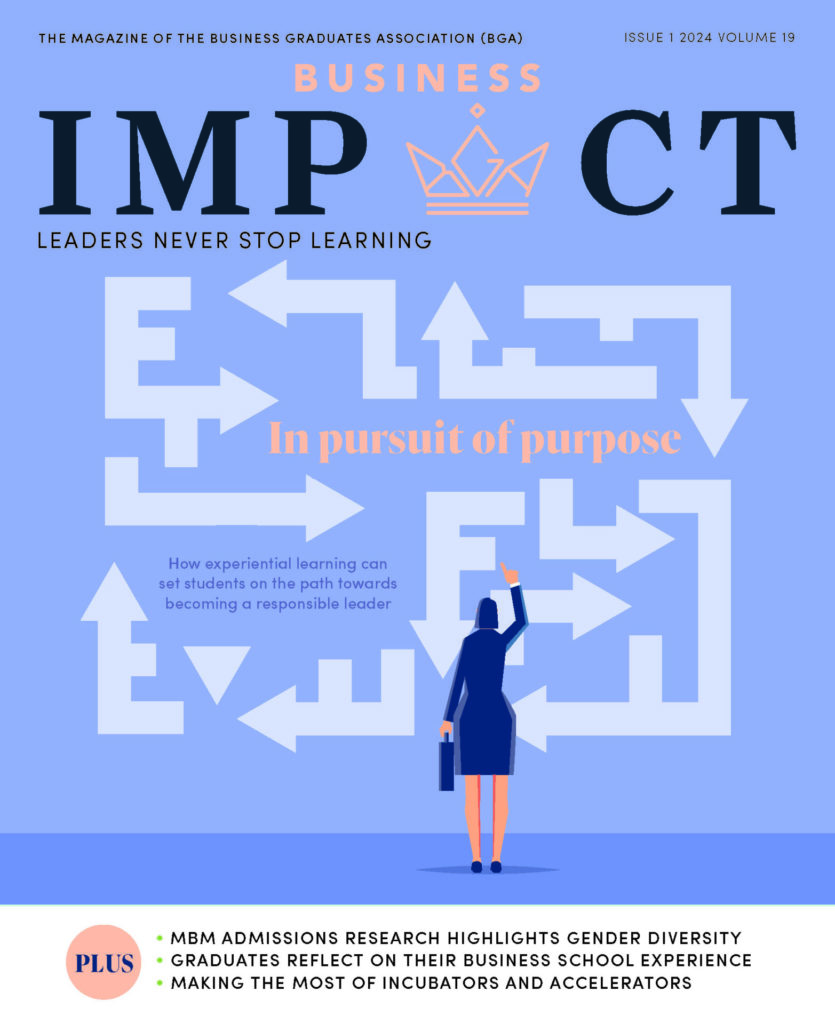Creating the foundation of being comfortable with being uncomfortable is a primary aim of the Interpersonal Dynamics leadership course at Chicago Booth, as outlined in the first part of this two-part article series. Within this, there is one key action we engage time and time again with ourselves and particularly with our students: the action of raising awareness.
We aim to raise awareness in our students in myriad ways. The course uses three main methodologies in particular: The learning laboratory of T-Group [a learning methodology devoid of structure and hierarchy that is described in more detail in the first part of this series], rigorous didactic classroom learning and self-reflection. This article will describe the classroom learning and self-reflection approaches in more depth further below. But first, why does raising awareness matter so much?
Why would anyone follow you?
With awareness comes choice. We want our students to be in the power of choice – as opposed to being hijacked by reaction – in all that they do. [Neurologist and psychiatrist] Victor Frankl put it best: “Between stimulus and response there is a space. In that space is our power to choose our response. In our response lies our growth and freedom.”
Our goal is to widen the space between stimulus and response in how our students communicate with one another. The ability to pause, assess, adapt and then act is a crucial leadership capability in any business career, let alone in life itself.
Raising awareness can be an uncomfortable process, especially when it relates to learning how you perceive the world and others, how and why you feel certain ways, as well as the impact of the behaviour of yourself and those around you. This brings us to another core element in the foundation of our teaching: our philosophy on change. In our combined years of psychotherapy and change management/leadership consulting, we have come to expect, teach and respect that change happens when there is discomfort.
The world of interpersonal dynamics is an adaptive one. While statistics and accounting aim to produce one right answer to any one problem presented in those fields, there is no one right way to interpersonally engage with people. Humans are complex and our students learn that what works with one person might not work for another. There is no one right way to lead people and leadership itself is an adaptive challenge. Influencing others without authority is an adaptive challenge and these challenges are often uncomfortable. So, learning how to lead and how to influence others requires discomfort. We instil in our students a curiosity around their leadership by asking the provocative question, “Why would anyone follow you?” Accurate, lasting learning resides in the intellectual and experiential pursuit to answer this question.
Creating the building blocks
With T-Group offering our students the experiential pursuit, the intellectual pursuit is provided by rigorous didactic classroom learning that introduces concepts and models. We want our students at Booth to see the forest and the study of leadership while being among the trees and the practice of leadership.
Within this layered expansion of enquiry, we introduce them to how philosophers and thought leaders think within the disciplines of leadership, psychology and organisational behaviour.
We also give students multiple weekly readings and assignments that offer deeper intellectual dives into the key concepts that have shaped this field of leadership and its surrounding study. While most other elements in our course tend to create more discomfort (which fosters learning and change), these didactic elements, using slides and lectures, provide intellectual stability that lowers the level of discomfort and prepares students for the likely uncomfortable practice later on.
Another intention in these didactic teaching elements is to raise awareness of the existing frameworks, models and dynamics happening beneath the surface during interpersonal engagement so that students can better observe themselves and be at choice in their actions. We layer the concepts we teach across weekly themes, such as ‘barriers to expression’ and ‘connecting across difference’. Each concept builds on the one before, creating the building blocks from fundamental interpersonal engagement to more advanced understanding in how to sustain, if not strengthen, business relationships.
Knowledge in action
The third important approach we use in Interpersonal Dynamics is self-reflection, which is learning about one’s mindsets, behaviours and consequences. We do this through the use of reflection assignments, or ‘reflection journals’ as we call it. In the journals, students write about their T-Group experience, what happened, what they did or didn’t do and why, and how they will choose to engage differently next time.
The reflection assignments provide an opportunity to inject concepts and knowledge into students’ learning, thus amplifying the laboratory portion of the pedagogy. They also provide the students with a chance to demonstrate their mastery of the subject matter as well as raise attention to knowledge gaps. The reflection assignments foster what Chris Agryris termed ‘double-loop learning’, which is an ability to examine their knowledge in action.
In an MBA programme well known for analysing data in economics and finance, Chicago Booth is now making waves by including feelings as valid data to raise leadership capability and interpersonal effectiveness. Through the learning laboratory of T-Group, rigorous didactic classroom learning and extensive self-reflection, Chicago Booth students are learning how to effectively give and receive feedback and build stronger relationships. After all, business is human.
This is the second of a two-part series. Learn more about the Interpersonal Dynamics course and approach to leadership taken at Chicago Booth in the first part of this article on Business Impact.
Headline image credit: Toa Heftiba on Unsplash









